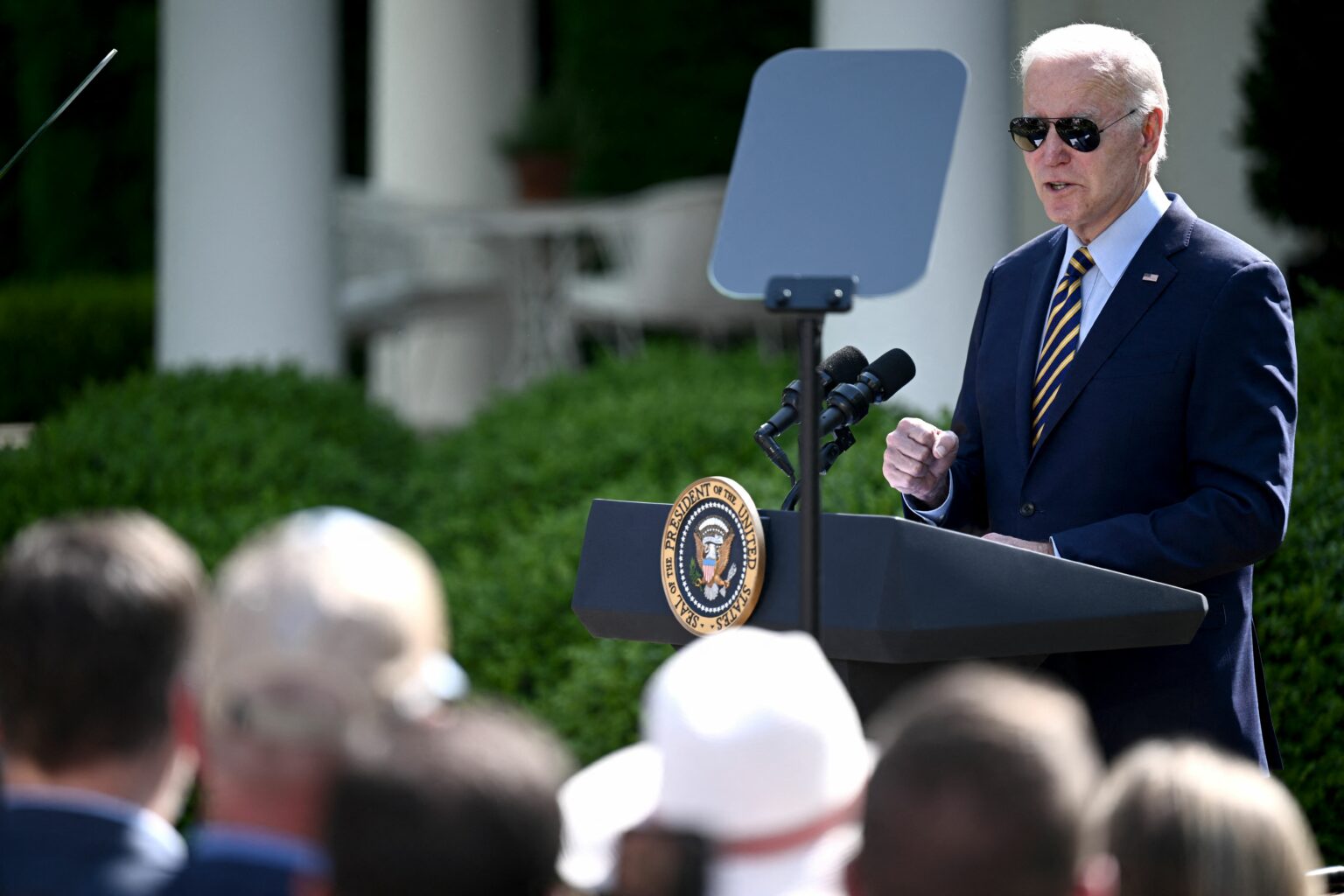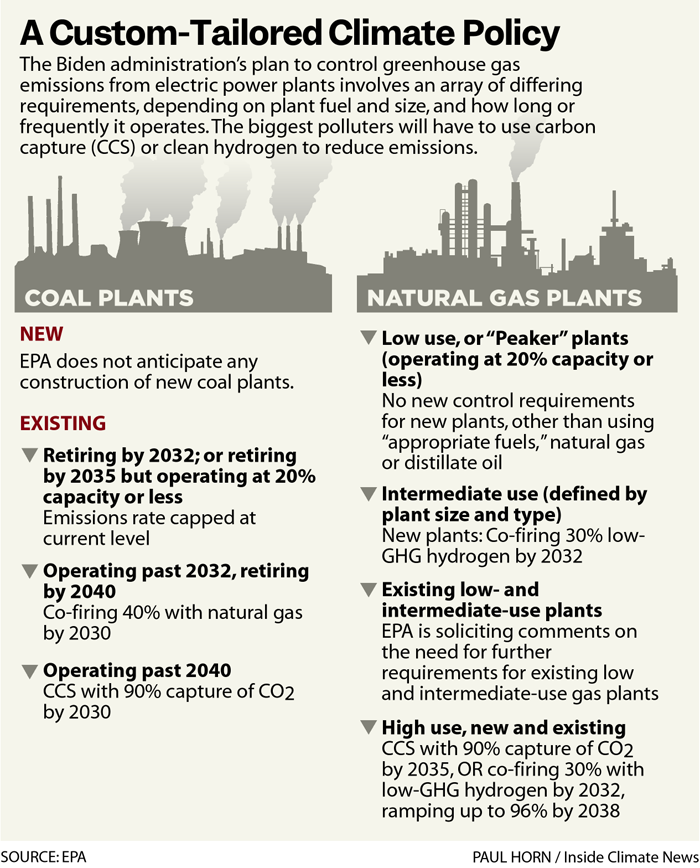 President Joe Biden announces plans to curb planet-warming emissions from the nation's power stations, as part of the efforts to combat climate change, in the Rose Garden of the White House in Washington, D.C., on May 11, 2023. Credit: Brendan Smialowski/AFP via Getty Images
President Joe Biden announces plans to curb planet-warming emissions from the nation's power stations, as part of the efforts to combat climate change, in the Rose Garden of the White House in Washington, D.C., on May 11, 2023. Credit: Brendan Smialowski/AFP via Getty ImagesWithout carbon-free power, it won’t be possible to cut greenhouse gas pollution from vehicles, buildings or industry.
But fossil fuel industry allies in both Congress and the states are ready to push back, using essentially the same argument they have used for years: the technology is not ready. They have the advantage of a Supreme Court dominated by Republican-appointed justices who favor limiting the historical role of regulatory agencies like the Environmental Protection Agency.
Clearly cognizant of these challenges, the Biden EPA produced a highly customized set of rules designed to give the power industry both time and options for cutting their greenhouse gas emissions. Large categories of coal and natural gas power plants—those that are going to close soon, or are small, or only run intermittently—will not face new requirements at all. And clean-up of the electricity sector will rely on two technologies—carbon capture and storage, or CCS, and clean hydrogen—that are receiving billions of dollars of federal subsidies approved by Congress over the past two years.
Moreover, no fossil fuel plant will be forced to install those technologies before 2030. Large natural gas plants have until 2035 or 2038 to equip themselves with carbon capture and other technology to cut emissions 90 percent. That suggests the U.S. won’t make it to Biden’s goal of 100 percent carbon-free electricity by 2035 on this rule alone, even if it survives all of the challenges that the industry and states are preparing to launch.
A preliminary analysis by the Center for Global Sustainability at the University of Maryland suggests the rule would help drive an 82 percent reduction in greenhouse gas levels from the power sector by 2040 from their 2005 peak. But that analysis concludes the rule is a “major step” toward the U.S. meeting its goal under the Paris agreement of cutting economy-wide carbon emissions 50 percent by 2030 and 100 percent by 2050.
Biden administration officials portray the new rule as just one component of a suite of policies—including the unprecedented $370 billion federal investment in clean energy from last year’s Inflation Reduction Act—that together will drive the U.S. to a net-zero carbon economy.
“The president’s 100 percent by 2035 goal for the power sector is his goal,” said Ali Zaidi, White House climate advisor in a briefing with reporters. “It’s been the North Star that’s guided policy as we’ve worked to modernize the grid, to accelerate innovation on clean energy technologies, to build out our capabilities here in the United States to manufacture clean energy technologies.”

The new proposed regulations are “part of that approach,” Zaidi said, calling them, “rules of the road standards that can help facilitate and reinforce that shift.”
Said EPA Administrator Michael Regan, “When you look at what is in this rule and has been proposed, we are absolutely in line with the president’s goal.”
Back to the Drawing Board
Power plants account for 25 percent of U.S. greenhouse gas emissions, making them second to vehicles as a carbon polluter. But their importance is far greater than those numbers suggest. Cleaning up power plants will enable carbon reduction in the transportation sector through electric vehicles, and in homes and businesses, through electric appliances.
President Barack Obama’s previous effort to control power plant emissions, the Clean Power Plan, was stayed by the Supreme Court in 2016. Since then, it’s been a long walk back to the drawing board.
The high court became reinforced with appointees of President Donald Trump who take a dim view on federal agency authority. Then, last year, in an unusual case led by West Virginia, the justices ruled that the EPA could not enact an Obama-style, system-wide give-and-take program for reducing greenhouse gas emissions from the power sector without explicit authority from Congress.
The Obama administration tried to offer industry flexibility through use of market mechanisms like emissions trading among power plants to achieve greenhouse gas reductions. Biden’s plan, authored by some of the same environmental lawyers who served Obama, still seeks to provide flexibility, but only “within the fenceline” of each individual power plant, as the Supreme Court signaled was necessary to pass legal muster.
The Biden team made other breaks from the Obama approach. No announcement in the White House Rose Garden (one Trump-appointed appeals court judge remarked during litigation that the fanfare was a sure sign it was a major policy that only Congress, not the administration, had authority to decide.)
Instead, Regan talked briefly on the rule at a University of Maryland event devoted to greater youth engagement on environmental issues. There’s no catchy name like the “Clean Power Plan.” The name of the 681-page regulation, more than three lines long in small print, begins, “New Source Performance Standards for Greenhouse Gas Emissions from New, Modified, and Reconstructed Fossil Fuel-Fired Electric Generating Units….”